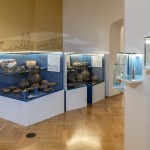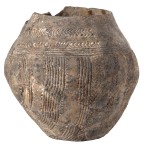The end and the beginning: Death and beliefs in prehistoric communities
The changing seasons, the sun, the cycles of the moon, death, life, fertility, all natural phenomena related to man and nature influenced beliefs in prehistoric times. They are evidenced by small objects and graves.
Burial practices and rituals are best known from graves dating from the Middle Copper Age to the Early Iron Age. All the analysed periods are characterised by the burning of the deceased on pyres and the placing of the remains in graves, most often in urns. Pottery vessels containing food and drink - a takeaway for the afterlife - were also often included.
Among the prehistoric ceramic finds, the so-called idols or figurines depicting stylised female bodies stand out. Some ceramic objects bear various symbols and images, such as spirals and crosses, or animals i.e. water birds. They are a small but important insight into the beliefs of the past.
Broken bronze and copper objects, mostly parts of sickles, but also axes and swords, were buried at the end of the Bronze Age for unknown reasons. There were many similar burials throughout Europe at that time. It was most likely a cult offering.




.jpg)
